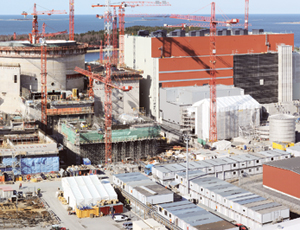As a standard-bearer for French plans to control one-third of the global nuclear powerplant market, Finland’s Olkiluoto project falls short of expectations. Delayed and mired in contractual disputes, the project is the world’s first to include new Franco-German reactor technology on which Paris-based Areva NP is hanging its ambitions.
Olkiluoto’s third unit (OL3) is the first of a kind, say Areva officials, in explaining some of the project’s difficulties, hinting that the joint venture may have bid too optimistically for the turnkey contract. Now in arbitration, the project is expected to end in 2012, not this year as planned.
The pressurized-water EPR’s second European outing, in northern France, seems more auspicious for Areva. Flamanville 3, near Cherbourg, has had some technical problems but could open on time, say officials of the owner, Electricité de France (EdF).
With two EPR’s ordered for China, Areva is taking the first steps in its plan to supply a third of the 150-200 reactors it forecasts will be built globally by 2030. To widen appeal of its standardized 1,600-MW reactor, Areva has quietly dropped the designation “European Pressurized-Water Reactor,” now using only the EPR acronym.
Areva’s next project could be in the U.K., “the first European country to restart an ambitious nuclear program,” says Luc Oursel, Areva NP’s president and chief executive officer. As the first “totally open” market, the U.K. “demonstrates nuclear is fully competitive,” he adds.
In the U.S., “people have totally understood the second wave of [nuclear] investment is coming,” says Oursel, noting increasing approaches from American utilities. “It is time for them to prepare.”
Areva’s own U.S. preparations include a nearly $2.4-billion investment in components manufacturing and uranium enrichment. It also is building a toehold in a possible long-term spent-fuel recycling business.
More than 80% owned by the French government, Areva has a potentially strong market position that owes much to its public-sector connections. Its main customer is the state’s EdF, whose nuclear plants account for nearly 90% of France’s electricity generation. EdF has always shopped at Areva and its antecedents.
Areva also has gained from the deep pockets and patience that only public-sector investors have. For example, the government retained capacity at Areva’s St. Marcel component-manufacturing base, near Chalon-sur-Saône, through the moribund market following the 1986 Chernobyl disaster. Business began picking up in the late 1990s and staff numbers almost doubled by 2004, says plant spokesman Frédéric Leconte.
In its 33-year life, St. Marcel has produced over 520 large nuclear fabrications, each of which demands many months’ precise and intensely scrutinized work.
It took over three years to assemble OL3’s first 25-meter-long steam generator, filled...











Post a comment to this article
Report Abusive Comment